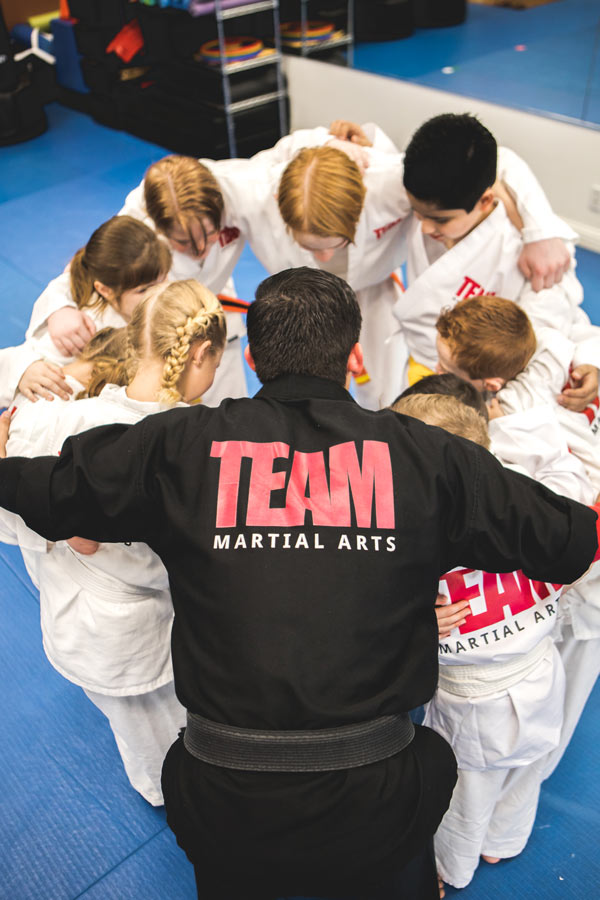October Is National Bully Prevention Month

October 2023
Did you know that one in 5 students reports being bullied in school? Research shows that bullying peaks in 5th, 6th, and 7th grades. Bullying is defined as behavior (words or actions) that hurts or harms another person and is intentional and repetitive. Bullying can include physical violence, rumors, name calling/insults, or being excluded from activities. Bullying can happen at school, online, or in texts.
The most effective ways to stop or prevent bullying involve action from more than just the bully and the person being bullied. Parents can play a very important role in preventing, detecting, and stopping bully situations.
One of the best ways to stop or prevent bullying is to make sure our kids have strong, positive communication and relationships with adults in their lives – with parents or other adult family members, and with authority figures including teachers and coaches. Kids who feel comfortable sharing their feelings and struggles with an adult are more likely to speak up when bullying is happening. Kids who have strong relationships with their parents or other adults are more likely to be confident in themselves and less likely to measure their self-worth by the words and actions of a bully.
We encourage parents to ask their kids questions about bullying, to stay informed and to start the conversation early. Questions such as:
- Do kids at your school use mean words to describe other students? To describe you?
- Does bullying happen at your school?
- Do you know what to do if you were being bullied at school? What if you saw someone else being bullied?
- Do you know which teacher or adult you would go to for help, if you saw someone being bullied?
If your child shares feelings about being bullied, or sees others being bullied, do your best to remain calm and listen. Assure your child that they can always come to you to talk. Next, talk with the school – sit down with a teacher or counselor to share your concerns. Make a game plan and stay in contact with the school.
Another effective way to stop or prevent bullying is for peers to intervene in a bully situation. Research shows that more than half of bullying situations stop when a peer intervenes on behalf of the student being bullied. Parents can teach their child to be a Buddy instead of a Bully. Being a buddy means practicing acts of kindness like asking someone sitting alone to join you at lunch, helping someone with their homework, or letting someone else go first. It feels good to surprise someone with an act of kindness.
When a Buddy sees someone being bullied, there are a number of things they can do:
- Get there first. If you see a bully approaching, ask the person being bullied if they want to go somewhere with you.
- Step in and Take Charge. Say something to the bully, like “Please stop right now, it’s not very nice and no one likes it.”
- Distract and Redirect. Walk up to the bully, pretend you don’t know what’s going on, say something to the bully like, “I like your shirt,” then ask the person being bullied to come somewhere with you.
- Leave and Report. If you’re not comfortable confronting the bully or interrupting, report it to an adult who has the authority to do something about
Finally, if your child is the one being bullied, there are tools they can use to stop bullying. They should be comfortable with the Five Rules of Personal Safety:
- Use Your Mind. Think about all the things you can do to stay safe, such as avoiding the bully and carrying yourself in a confident manner. Be aware of your surroundings so you can stop bullying before it
- Use Your Words. If a bully makes fun of you for something: stay calm, assert yourself, look the bully in the eye, and mean what you say. Stand tall and use a strong voice, even when you’re afraid, because an unconfident person is an easier target than a confident one. You can respond with an “I want” statement (“I want you to stop picking on me”); by using humor (“I’m glad you noticed my shirt is ugly, that’s the look I was going for”); by acting disappointed (“I can’t believe you said that, I never expected you to be a bully”).
- Use Your Legs. When your words aren’t working and you’re feeling unsafe, walk away if you can. Pretend the bully is invisible, look completely unfazed, or look at something else and laugh as you walk away. Don’t worry if someone calls you a chicken – it’s okay to be afraid and get away from a dangerous situation.
- Ask For Help. It’s perfectly okay to get help if you need it, from a teacher or You are not tattling if you ask for help. Tattling is when your motive is to get someone in trouble, but reporting is when you let someone who can help you know that someone is being treated in a disrespectful manner.
- Defend Yourself. This is the last rule, because you should try everything else Parents should talk with their student about self-defense, because every family has a different definition for what is acceptable. If you do have to defend yourself, we suggest the following five steps:
-
- Warrior Stance – create distance between you and the bully, stand sideways with your hands up and open, palms facing the bully (open hands, not closed fists)
- Tiger Eyes – take a deep breath, put a fierce look on your face, and look the bully in the eye
- Lion’s Roar – say in your most ferocious voice “Stop picking on me now. You are being a bully and I am not going to put up with it”
- Power Palms – if the bully comes toward you, strike at their face using the palms of your hands. Defend yourself with all your strength and spirt, but stop as soon as the bully is subdued
- Report Immediately – quickly leave the scene and tell a responsible adult exactly what happened
It is a good idea to use the “Three Times Guideline” when applying the Five Rules of Personal Safety. The first time a bully does or says something, and it’s never happened before, Use Your Mind (decide what you will do to avoid this type of situation next time). The second time it happens, Use Your Words. The third time, when words aren’t working, report to an authority figure. There are exceptions to these guidelines – if someone punches you, you should defend yourself and report immediately, rather than waiting to be hurt again.
Parents should talk with their student about what to do in a bully situation, since every family has their own standards and rules for personal safety, physical contact, etc. Talking calmly in a neutral environment before something happens can lead to better decision-making when faced with a real bully situation.
